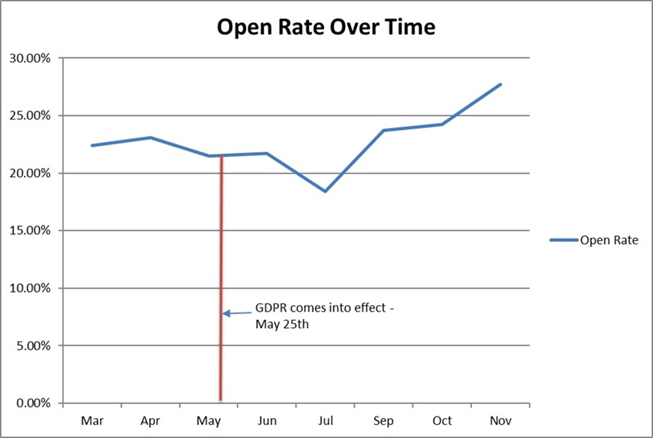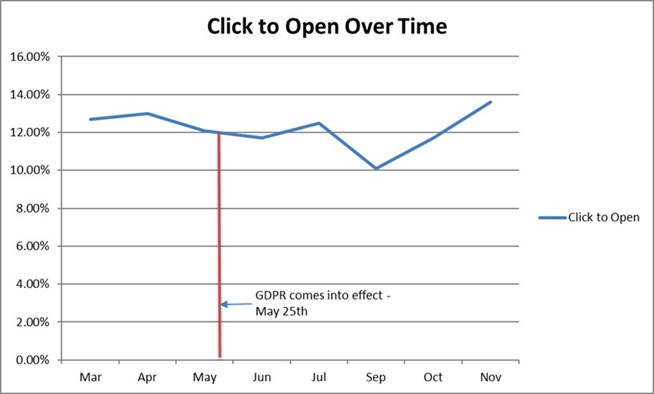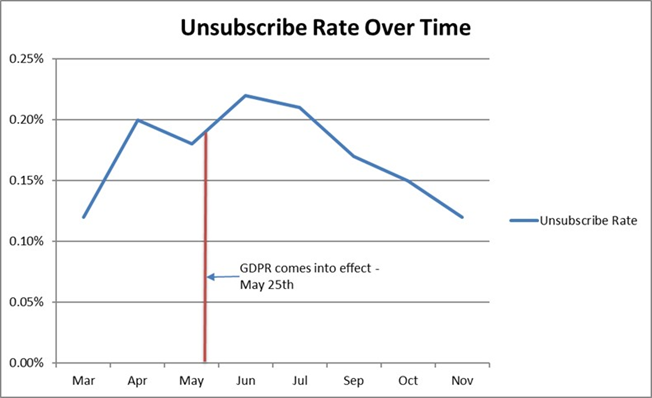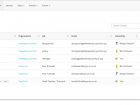The 3 Graphs That Show the GDPR’s Impact on Marketing to Schools
The 3 Graphs That Show the GDPR’s Impact on Marketing to Schools
In this blog, John looks at what impact the GDPR really had on marketing to schools and, importantly, where this takes emailing teachers...
In this blog, John looks at what impact the GDPR really had on marketing to schools and, importantly, where this takes emailing teachers...

Do you remember that week back in late May when our inboxes were suddenly crammed full of fair processing notices, repermissioning emails, and “you’ll never ever hear from us again unless you click this really important button” messages?
It feels like such a long time ago now, but back then GDPR was the only game in town. For 7 days at least even Brexit was pushed into the background and the only cliff edge people were worried about was the one approaching on the 25th May 2018!
At Sprint Education, we always looked upon the GDPR more as an opportunity to do things better than a threat to our future (you can read about how we used GDPR as the spur to reinvigorate how we help businesses sell to schools here). However, even we were a little unsure about how the GDPR would impact upon open, click and unsubscribe rates moving forward.
Now, six months down the line and with the dust well and truly settled, we thought it was a good time to evaluate what tangible impact the GDPR has had on our clients’ email marketing to schools.
The Impact on Open Rates:

If we look at the graph above we can see that open rates did decrease both in the run-up to the GDPR coming into effect on the 25th May and in the 6-8 weeks afterwards. This matches a trend reported by the Data & Marketing Association who conclude that although people initially valued the GDPR-related emails they received from businesses, these later became so overwhelming that people had no option but to start ignoring them. This undoubtedly contributed to a slight decrease in open rates from all marketing during this period.
However, the great news is that from late July onwards open rates started climbing sharply. So much so that, as I sit typing this blog, our clients are seeing the highest open rates from their marketing in over 12 months!
So why the big upturn in open rates for our clients in this period, and is this trend unique to the education sector or part of something bigger? Well, interestingly, a study by digital marketing research group Netimperative found that retailers across the EU have halved the number of marketing emails they are sending since GDPR, but those emails are now 30% more likely to be opened! It would appear that, if anything, the GDPR has given email marketing a shot in the arm that means it is now performing better than it has done for some considerable time.
But can the upturn in our clients’ open rates be attributed to us sending less marketing to teachers? Actually, no, it can’t. The number of email campaigns we are sending to teachers has stayed roughly flat over the period March – November.
It’s much more likely that this increase in open rates has been as a result of all the process improvements we’ve made over the last few months now coming to fruition. In our recent, Blueprint for Success whitepaper we explained how the process of opting in teachers through our Teacher Perks website has led to them being more emotionally (and sometimes financially) invested in our clients’ marketing.
This, and other similar improvements, have undoubtedly encouraged teachers to view our clients’ marketing emails in a more positive light, which can only have had a positive impact on open rates.
The Impact on Click-to-Open Rates:

Perhaps predictably, the click-to-open rates our clients have experienced over the same period have not fluctuated anywhere near as much as open rates. The click-to-open rate is really a measure of the performance of the email content than anything else and so will have been less affected by GDPR.
Having said that, we did still see a slight downturn in click-to-open rates in the lead-up to the GDPR and in the immediate aftermath. Once again, this can probably be largely attributed to teachers’ inboxes being overloaded with GDPR-related notifications, leading to them disengaging from marketing emails in general over this period.
We did see a sharper drop in September, at the start of the new academic year, which is harder to account for, but since then click-to-open rates have grown steeply and are now even higher than they were back in March. More great news for our clients!
The Impact on Unsubscribe Rates

The unsubscribe rate is another key performance indicator for us when we look at how positively teachers are receiving our clients’ marketing.
We pride ourselves on having an unsubscribe rate way below email marketing industry averages. To provide a couple of useful benchmarks for the above statistics, the average unsubscribe rate for all UK SME email marketing campaigns in 2018 (as listed in SIGN-UP.TO’s Benchmark Report) is 0.49% and the average when we look at the education sector specifically is 0.51%. So we’re way below those averages when sending our clients’ campaigns, which is great!
As you can see from the above graph, our clients’ unsubscribe rates certainly went up in the 6-8 weeks leading up to the GDPR coming into effect. This is not really surprising given the fact that GDPR was such a big news story. The biggest increase in the unsubscribe rates was during the 3 week period covering 18th May – 8th June when everyone’s inboxes were deluged with GDPR-related notifications. Hardly surprising.
However, from that point on, our clients’ unsubscribe rates started dropping steeply and are still falling today – down to just 0.12% at the end of November!
So why are our unsubscribe rates so low when compared to the education sector? Part of the reason is undoubtedly the marketing to schools ecosystem we’ve created through Teacher Perks, which has led to teachers becoming more invested in the marketing process. However, there are lots more reasons too, which you can read about in our GDPR Impact whitepaper which summarises the steps we’ve taken not just to comply with the regulation, but to go way beyond.
All of this leaves us in an extremely healthy place with open rates and click-to-open rates both currently at their highest for over a year (and continuing to rise) and unsubscribe rates returning to the levels seen in March.
Simply put, there’s never been a better time to email teachers with Sprint Education. So, if you’ve taken your focus away from email marketing in the last few months it’s certainly time to return to it. Give us a call on 01684 297374 or email me personally at john@sprint-education.co.uk and let’s have a chat about your plans for 2019.
Tags
Emailing Teachers
How to Sell to Schools
Marketing to Education
Marketing to Schools
Marketing to Teachers
Similar Articles


What Type of Education Business Are You?
We identified three distinct types of education business last year. Here's how their approaches to the pandemic have played out in 2021.


Gathering education insights (8 quick tips)
Learn 8 quick tips to improving your education marketing strategies with direct school insights, and the benefits of online studies and surveys.


Expert marketing to schools support and solutions
Expert marketing to schools solutions
Email Head Teachers, Teachers, and Staff Inboxes
Email teachers and staff inboxes
Sell More to UK and Global Schools and Colleges
Sell more to schools and colleges

































